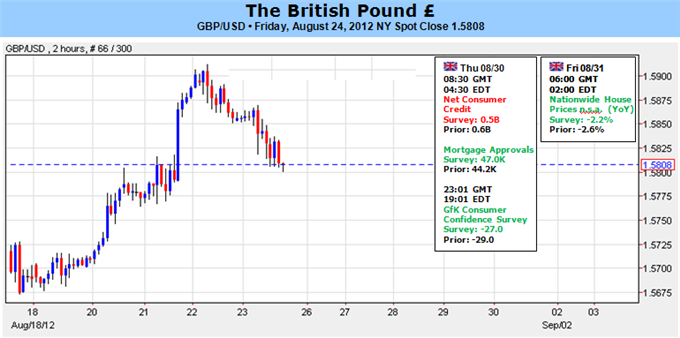
A bare-bones domestic economic calendar leaves the British Pound at the mercy of broader market themes, putting the spotlight on the evolving outlook for global economic growth and the festering Eurozone debt crisis. Sterling remains anchored to risk appetite, with the benchmark GBPUSD exchange rate continuing to show a strong correlation with the MSCI World Stock Index. With that in mind, the UK unit may find itself under pressure as the markets’ loss of patience with EU officials’ sluggish crisis-fighting efforts and a disappointment of hopes for additional Fed stimulus make for a risk-averse environment.
On the growth side of the equation, all eyes will be on Friday’s Jackson Hole symposium and a speech from Fed Chairman Ben Bernanke. The central bank chief used the venue to unveil QE2 in 2010 and traders are speculating that the third round of asset purchases may emerge this time around. Last week, a dovish set of minutes from Augusts’ FOMC sit-down fueled bets on imminent accommodation, but dismissive comments from St. Louis Fed President James Bullard quickly poured water to the doves’ exuberance. Bullard said the minutes were dated in light of the improvement in US economic data through July and August, hinting the Fed may not see the landscape as warranting a reboot of asset purchases. Top-tier US data releases crossing the wires late into the week printed north of expectations, seemingly reinforcing Bullard’s position.
Faced with these conflicting cues, traders will closely monitor next week’s stock of manufacturing survey data from the Dallas, Richmond, Kansas City and Chicago Fed branches to set the stage for Bernanke’s speech. The Beige Book survey of regional economic conditions and Augusts’ Consumer Confidence reading will likewise meet with close scrutiny from investors. On balance, an unequivocal nod toward QE3 seems unlikely. Medium-term inflation expectations remain reasonably anchored near the Fed’s target 2 percent rate and borrowing is materially cheaper than it was when QE2 emerged, with Treasury bond yields sitting just off record lows. US has economic data has also performed increasingly better relative to expectations since mid-July, suggesting the need for added support is less than urgent. That means the Fed is likely to reserve QE3 as an available tool in its arsenal in the event that the mess in Europe triggers another credit crunch akin to the aftermath of the bankruptcy of Lehman Brothers in 2008.
Turning to the Eurozone, last week’s anticlimactic developments in Greece and further stalling from the ECB on its bond-market support program revealed investors’ frustration with a lack of directional cues – whether positive or negative – from Eurozone officials. Markets may be approaching a juncture where price action forces policy once again, with risk aversion breaking out amid signs of continued dithering. The focus will be on a meeting of German and French finance ministers, a formal review of the EU/IMF bailout program for Portugal, and a set of bond auctions from Spain and Italy (where average yields and bid-to-cover readings will be closely monitored as a gauge of funding stress). With little in terms of a breakthrough likely on the horizon, a round of risk aversion may be brewing to punish policymakers’ foot-dragging. Importantly, while such an environment is expected to hurt the Pound against established havens such as the US Dollar and the Japanese Yen, it may be uniquely supported against the Euro as regional capital flows seek an alternative to the single currency.
ليست هناك تعليقات:
إرسال تعليق